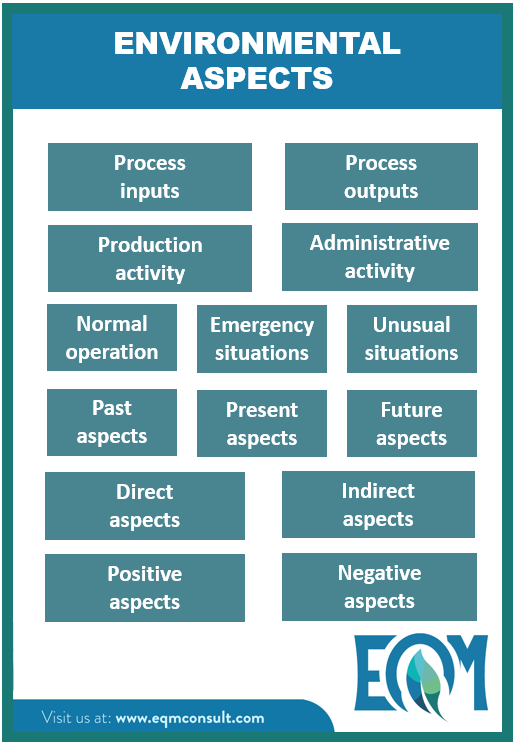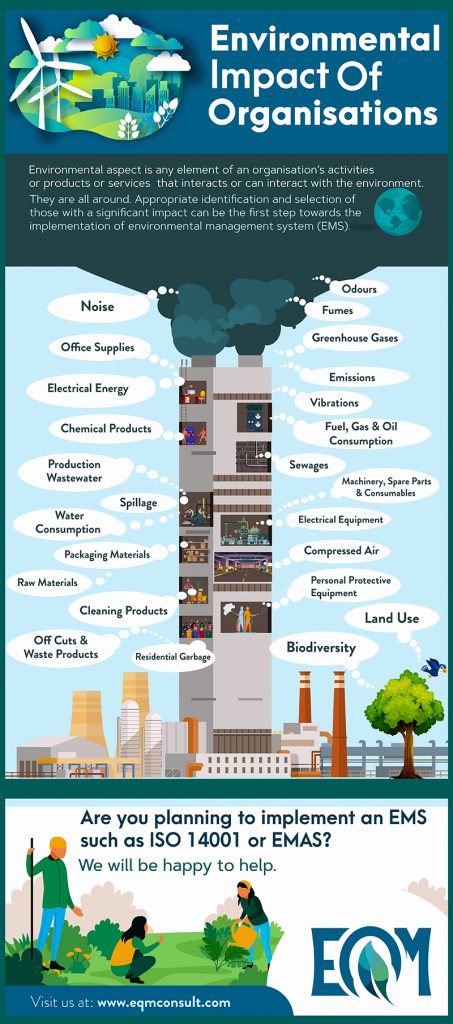
Companies that wish to minimize their negative impact on the environment can implement an environmental management system (EMS) compliant with the international standard (ISO 14001) or EMAS Regulation.
One of the most important elements of an EMS is the identification of so-called environmental aspects and selection of those that have a significant impact on the environment. Environmental aspects are all around us, and in the simplest words, the environmental aspect is “every element of an organisation’s activities, products or services that has or can have an impact on the environment.” There are three important components of environmental aspect management – Identification, Assessment, and Action. Let’s have an in-depth look into all three of them.
1. Identification
First, the organisation should determine all environmental aspects that can be controlled (either directly or indirectly). If your business employs an in-house environmental management expert, they should have the necessary knowledge of ISO 14001 standard or EMAS to allow comprehensive identification.
Emissions may be an example of the environmental aspect, this may include greenhouse gas emissions, dust emissions, odours or fumes. The consumption of resources (such as water, electricity, fuels, oils) may be an environmental aspect as well.
The environmental aspect can be an input to processes (aspects such as raw materials, semi-products, chemicals), but as well it can be output from the processes (for example product – which ultimately become a waste, packaging, production waste, wastewater or sewage).
Environmental aspects can be related to the production activity (for example machinery, spare parts, consumables, personal protective equipment), but also with administrative activities (such as electronic equipment, printing toners, paper).
Most aspects are related to the normal operation of the organization, but it is also necessary to identify emergency aspects, which may be leakages or fire gas emissions, and aspects related to unusual situations or special activities, such as renovation (for example waste packaging of paints and varnishes).
When identifying environmental aspects, past, present and future activities related to planned projects and modifications should always be taken into account. In addition, both – direct aspects (related to the activities, products and services over which the organisation has direct control) and indirect aspects (aspects on which the organisation may have some influence, resulting for example from relations with third parties, such suppliers).
It is not surprising that most of the environmental aspects harm the environment (at least for some degree), but there are also examples of positive environmental aspects such as planting.

During the identification of environmental aspects, businesses should consider the entire product life cycle, from design to disposal.
Various techniques can be used to compile all the environmental aspects such as the value-chain method, materials identification, process flow method etc. It is usually a good practice as well to use a process map and identify individual inputs and outputs.
The identification of environmental aspects is a key element for the successful EMS and sometimes it can be quite complex, therefore businesses often work with expert environmental management consultants to help them identify environmental aspects and create a robust EMS. These consultants consider the existing and future business activities and devise a comprehensive plan to mitigate environmental hazards.
2. Assessment
Environmental aspects with significant impact should be the core focus of an organisation. To select them it is needed to determine the assessment criteria and use them to assess each aspect identified during step one.
During the assessment, we should consider normal operating conditions as well as emergency and special conditions. The criteria should be tailored to meet the unique requirements of your business and should be properly documented for review, improvement, and further use.
When selecting criteria for assessing environmental aspects, businesses can consider the following list:
- the legal requirements,
- the severity of the impact,
- duration of the impact,
- frequency of impact,
- area of influence (local, regional, global),
- environmental sensitivity,
- reversibility of changes in the environment (cost and difficulty of making changes and restoring of environment back to its previous state),
- probability of occurrence,
- opinions of interested parties and impact on the social perception of the organisation,
- activities related to public procurement or purchasing processes,
- organisation processes (design, development, production, distribution, maintenance, use, reuse, recycling, disposal).
One of the methods for the assessment of the environmental aspects is FLIPO considering criteria such: Flow, Legislation, Impact, Practices and Opinions.
| 3 | 2 | 1 | |
| Flow | Very important | Important | Normal |
| Legislation | There is a legal requirement or regulation, and it is not met | There is a legal requirement or regulation, and there is a risk of not meeting | There is no legal requirement or regulation, or regulation is met |
| Impact | The aspect is dangerous, it influences the environment and/or affects human health | The aspect is probably not harmful, but in large amounts, it can cause a hazard | The aspect is not harmful |
| Practices | To be ceased immediately | To be changed | To be checked |
| Opinions | There are complaints about the company’s environmental impact | There is the general interest of stakeholders (internal or external) | There is no interest of stakeholders |
FLIPO method requires to score each aspect using the above five criteria and then sum the points. Each environmental aspect can get from 5 up to 15 points. Individual aspect is considered significant when the sum is equal or more 8 or in case that any of the criteria was scored 3 points.
3. Action
After the identification of aspects and selection of those critical, the significant aspects should be brought under control through a robust environmental management system and comprehensive improvement plan. In this respect, it will be necessary to decide what needs to be done to minimise negative impact, how it will be achieved, which resources will be required to achieve this, who will be responsible, what is the required timeline to achieve the improvement and how the business will monitor the status of an action and its effectiveness.
Implementing an EMS can become complicated; therefore, it is vital to consult experts such as EQM consult, who can help you devise a strong environmental strategy. We provide environmental management system audits to help you create a strong EMS and we help implement environmental management systems that comply with ISO 14001. You can check our website for more information about the services, or contact us for a consultation.


Ph.D. Beata Paliwoda
Founder and Owner of EQM. Environmental and quality consultant and auditor. Professional career built in Quality Assurance departments in various companies from the automotive, aerospace, railway industries, as well as a management systems consultant. Successfully completed many complex projects related to the implementation of management systems, process improvements and business transformation. Auditor of ISO 9001, ISO 14001, AS 9100, project manager of APM, lecturer at the Poznan University of Business and Economics, researcher on the effectiveness of EMS and QMS in organisations.





